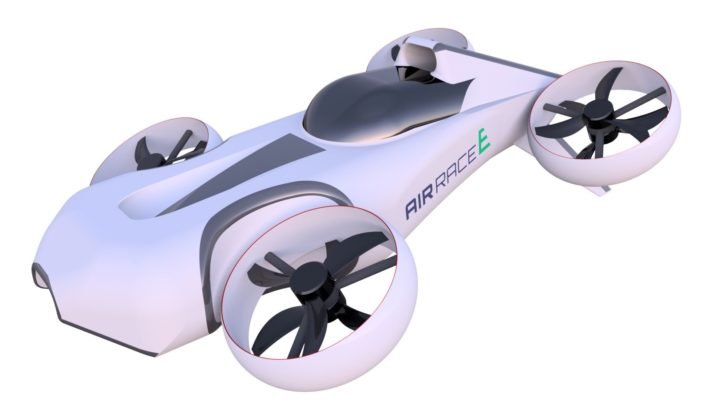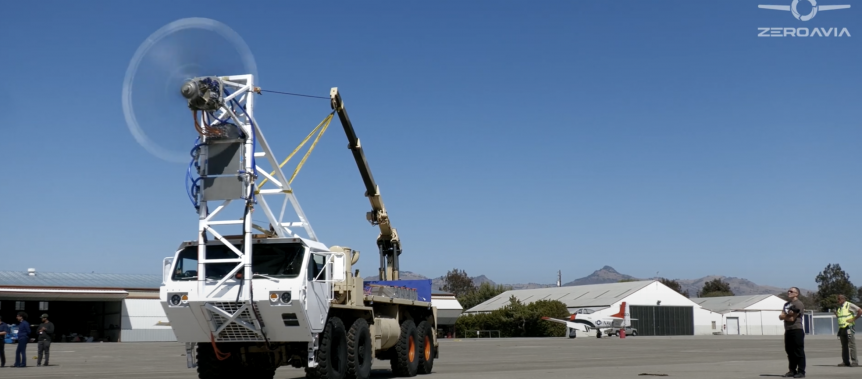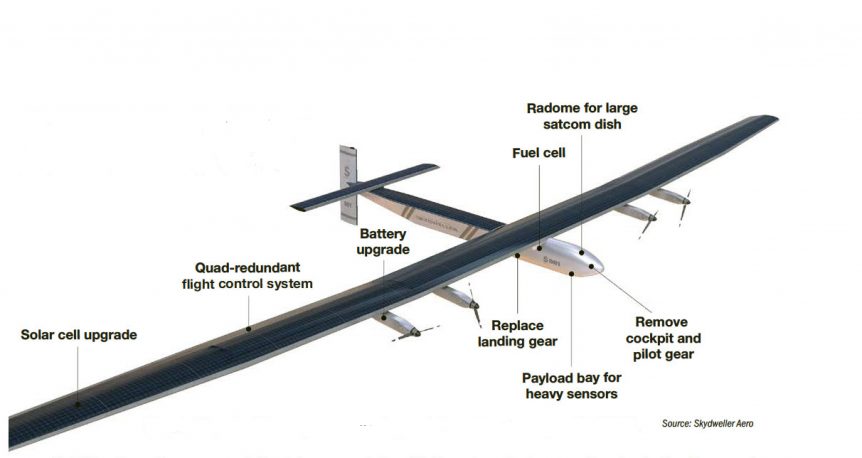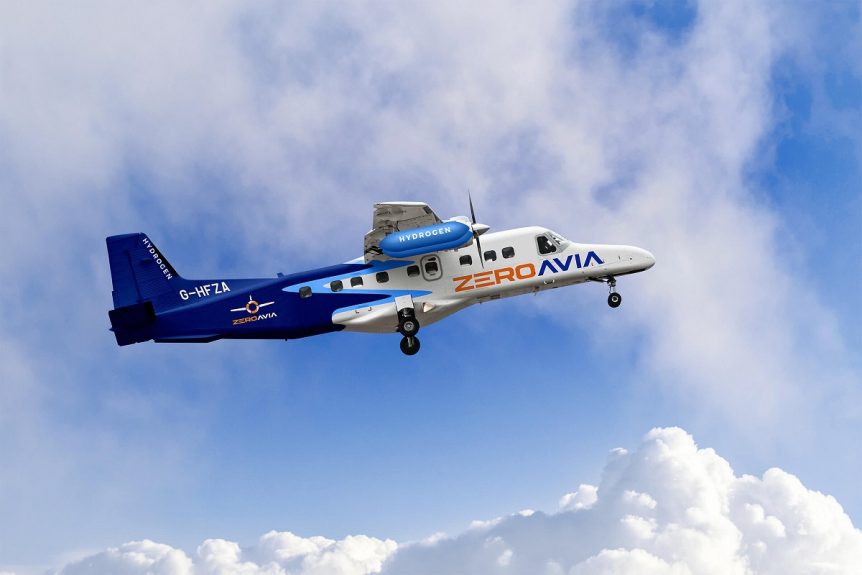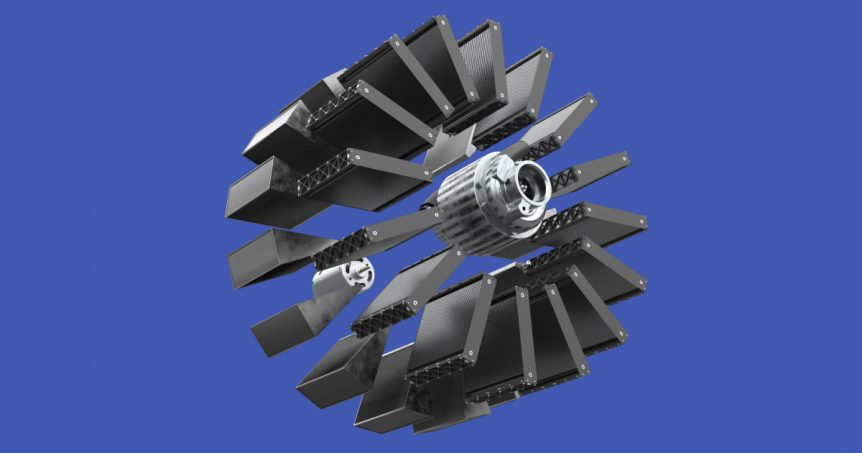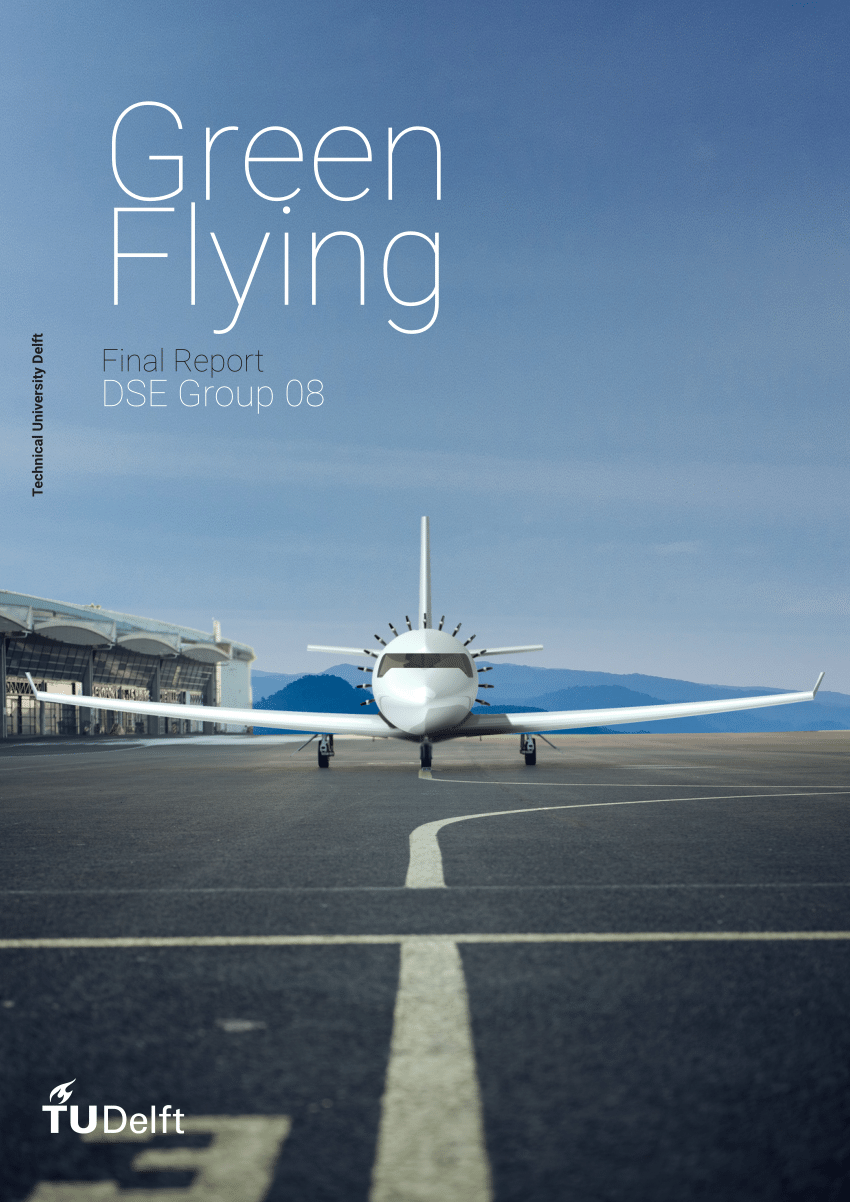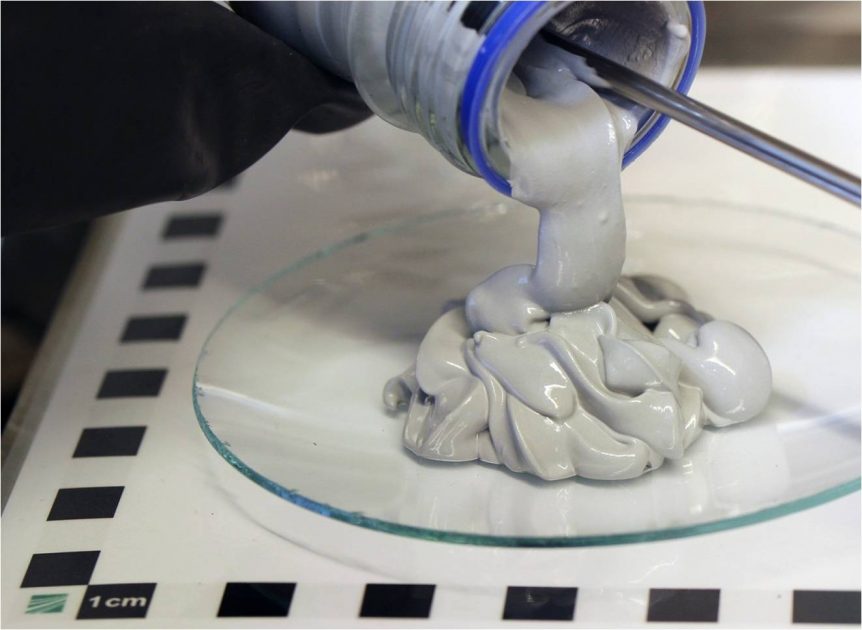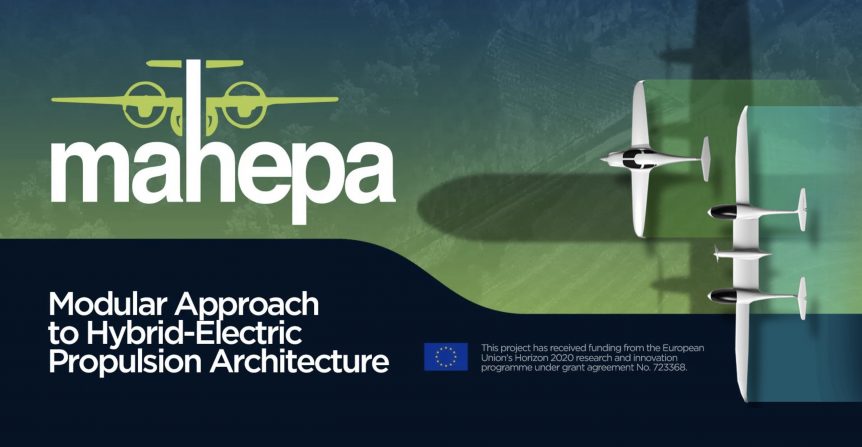“The electric VTOL class is an entirely different category of aircraft altogether. Often referred as “flying cars”, this type or aircraft is at the forefront of electric technology in aerospace. Brace yourself for The World’s First Vertical Motorsport! This race format and its rules will be somewhat different than the airplane classes and will be revealed soon.” Air Race E promotion. Possible Contenders The Alauda Airspeeder Two possible contenders (mostly) ready to race come to our attention. The first is the Alauda Airspeeder, shown here in its Mk. 3 version. And by dint of the International Dateline, the craft’s most recent flight came to us the same day it was recorded. One may question how open-rotor racing at high speed can be made safe. Alauda alludes to Acronis Cloud Protection. “The racing series, created by performance electric flying car manufacturer Alauda, will receive technical and commercial support from Acronis, with some of the services delivered by a global provider of …
ZeroAvia Tests 600 kW Motor, Receives Honors
Val Miftakhov, founder and CEO of ZeroAvia, introduces tests of the company’s 600 kilowatt powertrain, mounted high atop their new mobile test bed. In recent months, the company has achieved some solid recognition. “In July, 2021, ZeroAvia has successfully tested high-power operation of its flight-intent ZA-600 (600kW) powertrain. The testing has been done on the brand new HyperTruck mobile ground testing platform ZeroAvia has developed based on a heavy-duty M977 HEMTT military truck. The HyperTruck platform is designed to be able to test not only the current 600 kilowatt system for 10-20 seat applications, but also the 2 Megawatt system currently in design phase, targeting 50-80 seat aircraft. The latest series of tests signifies a critical milestone before flight application of these powerplants later this year in the company’s 19-seat test demonstrator.” Further down the line, plans for a 40-80 seat hydrogen-electric aircraft are in store. Perhaps the high mounting of the powerplant comes from Head of Drivetrain development, Gabriel …
A Pulitzer Written in the Sky
Itching to test your electric airplane’s cross-country capabilities? A new Pulitzer Electric Air Race of over 1,000 nautical miles (1,150.78 statute miles to be exact) between Nebraska and North Carolina will show who has the fastest electric flying machine. Jim Moore, reporting for the Aircraft Owners and Pilots Association (AOPA), shows the connection between the original Pulitzer Trophy and today’s electric competition. “Five of the first six pilots to have their names engraved on the Pulitzer Trophy were military airmen clocked around a closed course at speeds starting at 157 mph in 1920, up to a blistering 248 mph by 1925. The trophy was created to inspire innovation, and particularly faster airplanes. That vintage trophy housed at the Smithsonian National Air and Space Museum will be engraved with its first new name in 97 years in 2022, following completion of a 1,000-nautical-mile cross-country race by up to 25 electric aircraft.” Ralph Pulitzer was son of Joseph Pulitzer, whose prizes for …
Skydweller Seeks Ultra-Persistence
Skydweller Aero, an adaptation of Solar Impulse technologies, is working with the U. S. Navy to provide ultra-persistent flight capabilities. It’s using Solar Impulse Two, for which Skydweller purchased the assets and intellectual property rights. Being flown in Spain at this time, the aircraft’s 2,900 square feet of solar cells provide two kilowatts of power, and may be augmented by hydrogen fuel cells in future. In Spain Skydweller founders John Parkes and Robert Miller have headquarters in Oklahoma City, Oklahoma, but are performing flight tests in Spain, coordinating efforts with the University of Castilla-La Mancha (UCLM). After successfully completing ground tests that checked the structure and control systems, Skydweller works toward crafting the software that will guide it on unpiloted missions, scheduled to last at least 30 to 60 days. Such persistence, long sought by the military for ISR (Intelligence, Surveillance and Reconnaissance) missions, is also essential for many future civilian applications. Co-founder John Parkes explained this to Aviation Today. …
Going Big and Bigger with Hydrogen
Two companies promoting hydrogen power for aircraft are upsizing their aspirations, with aircraft hauling four to up to 40 passengers. Both have ambitious timelines. ZeroAvia, operating in Hollister, California and Cirencester, England has been flying a Piper Malibu demonstrator, but anticipates flying a 10 to 20 passenger Dornier by 2024. It would expand that to a 50-passenger craft by 2026. H2Fly in Germany has been flying their Pipistrel-designed HY4 for several years and through six generations. The firm looks forward to taking incremental steps toward a 40-passenger regional airliner by 2030. ZeroAvia ZeroAvia reports on troubling trends in aviation’s contribution to greenhouse gases, but follows with a possible solution. According to their web site, aviation accounts for over 12 percent of total transportation emissions, and may double that by 2050. High altitude contrails mean aviation emissions have two to four times the effect of ground source emissions. Regulators want drastic changes. The European Union mandates a one quarter the CO2 …
Hypoint’s Radical Radial Fuel Cell Solution
Hypoint proclaims, “We make zero emission air transport possible.” They do this by, “Building a next generation hydrogen fuel cell system that can deliver “Both high specific power: “2,000 Watts/kilogram and high energy density “1,500 Watt-hours/kilogram Exactly what aircraft designers are looking for.” These numbers exceed what the best batteries can manage at this time, and according to the company’s white paper, even better performance is on the way. Batteries vs. Fuel Cells Hypoint proclaims, “The age of zero-emission aviation is currently being prevented by the industry’s reliance on Li-ion batteries, which have a fundamental barrier at the chemistry level.” The firm limits cell performance to 200 Whr/kg, although Bye Aerospace claims 260 Whr/kg for their full battery packs, battery management systems and all. Elon Musk disagrees. CNBC reports, “Tesla co-founder and CEO Elon Musk has dismissed hydrogen fuel cells as ‘mind-bogglingly stupid,’ and that is not the only negative thing he has had to say about the technology. He …
Two Hydrogen-Powered Aerial Vehicles
Two very different hydrogen-powered aerial vehicles have come to our attention, each with a different mission, but both with endurance and range as primary functions. Both use a fairly straightforward fuel cell/motor arrangement to power their flights. Vicor/DMI Fuel Cell Drones Doosan Mobility Innovation (DMI) is a major drone manufacturer, and their largest products push against the FAA’s 55-pound (24.97-kilogram) weight limit. Their DM30, powered with a DS30 fuel cell and a 10.8 liter H2 tank weighs 21 kilograms and can carry a five kilogram (11 pound) payload. Carrying a full payload may require using the smaller seven-liter tank. Alessandro Mascellino, writing in EE Power, describes recent combination of resources that makes long-range drone deliveries possible. “The first machines built as part of the collaboration can fly two hours on a single charge and have already transported masks and emergency supplies between US Virgin Islands. The drones feature a number of power components by Vicor.” Partnering with Vicor, Doosan provides …
Two Ways to Haul 19 on H2
Pipistel and Delft Technical University have introduced hydrogen (H2) powered, 19-seat airliners for the intermediate-range market. Both are unique configurations with unique propulsion concepts. Both attempt to lower drag through the use of their propulsive systems. Pipistrel Miniliner Pipistrel announced their Miniliner concept as a response to a “significant market potential” for a “zero-emission airplane in the 20-seat size class, capable of operating quietly from runways shorter than 1 [kilometer], including grass airstrips at small aerodromes.” Seen as a disruptive element in providing service to currently unserved areas within a 200 to 1,000 kilometer (124 to 620 mile) range, the Miniliner could also serve as a microfeeder craft between small airports and large hubs. Although Pipistrel is somewhat mum about the internal and powerplant details for the craft, the propeller locations seem to indicate a major effort to reduce drag and eliminate wingtip vortices. The tail, for instance, is very much what Bruce Carmichael, a proponent of laminar-flow designs, proposed …
Hydrogen as a Goop? Fraunhofer’s Powerpaste
Not Gwyneth Paltrow’s Goop What if a different approach to storing hydrogen as a fuel gave benefits that are easily disbelieved? Would this new fuel find approval and widespread adoption? Ask the Fraunhofer Institute for Manufacturing Technology and Advanced Materials (IFAM) in Dresden, Germany. The Institute has come up with something called Powerpaste, claimed to be, “A safe way of storing hydrogen in a chemical form that is easy to transport and replenish without the need for an expensive network of filling stations.” (Fraunhofer describes the paste as a “goop,” not to be confused with the very different fluids marketed by Gwyneth Paltrow under the “Goop” trade name.) We’ve seen hydrogen flying for several decades, with Michael Friend leading a Boeing project to launch the first fuel-cell powered craft in 2008 and Gérard Thevenot flying his H2 fueled “trike” across the English Channel in 2009 using only 550 grams per hour on his crossing, which took a little over an …
MAHEPA and HY4 Go High
MAHEPA (Modular Aproach to Hybrid-Electric Propulsion Architecture) is a European Union project to build emission-free aircraft. A public flight of Pipistrel’s HY4 hydrogen-powered, four-seat aircraft was the latest demonstration of the group’s progress. Challenging Objectives Overall, MAHEPA hopes to accomplish five objectives: Advancing the fuel-driven serial hybrid-electric Powertrain which uses a lightweight internal combustion engine (ICE), capable of running multiple fuels as the power generation module. Advancing the reliability of zero-emission serial hybrid-electric powertrain which uses a Proton Exchange Membrane (PEM) Hydrogen Fuel Cell (FC) as the power generation module. Advancing new airborne qualified, lightweight, high-power density components such as a 200 kW+ electric motor, a 100 kW+ generator and improved power electronics using Silicon Carbide (SiC) technology to increase efficiency of power transmission due to decreased switching losses. Developing “common building blocks” solutions also for different aircraft configurations, enabling the proliferation of powertrain modules between various aircraft. Gathering, analyzing and comparing in-flight performance and emission data in order to …

